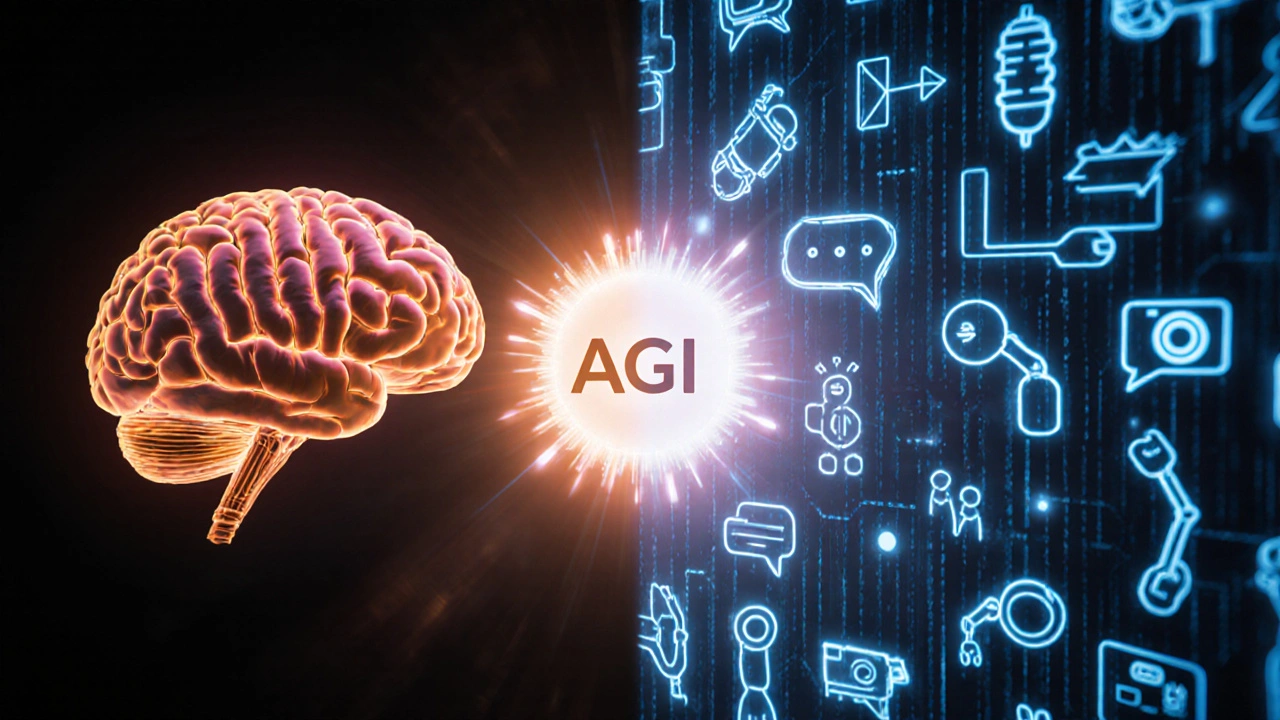AGI Timeline Calculator
This calculator estimates when AGI (Artificial General Intelligence) might become viable based on current research factors. The median prediction from AI experts is 2037, but timelines vary widely depending on breakthroughs.
Estimated AGI Arrival Year
This calculation shows the median prediction from the 2024 Stanford AI Index survey. Our model suggests a 50% probability of AGI by this year.
Quick Takeaways
- AGI aims to match or surpass human general intelligence across any task.
- Current AI systems are "Narrow AI" - experts at specific problems but not flexible.
- Three main paths: brain‑inspired cognitive architectures, scaling deep learning, and hybrid symbolic‑neural systems.
- Safety, alignment, and compute limits are the biggest hurdles before AGI arrives.
- Most experts forecast a viable AGI sometime between 2030 and 2045, with major societal impact.
What is Artificial General Intelligence?
When people talk about the next leap in AI, Artificial General Intelligence is described as a type of intelligence that can understand, learn, and apply knowledge across any domain, just like a human being. Put simply, AGI would be able to pick up a new skill - say, playing a musical instrument - with the same ease a person does, without needing a custom‑built model for each task.
In contrast, the AI you see today - from chatbots to image classifiers - is *narrow*; it excels at a single function but can’t transfer that expertise elsewhere. That distinction is why the term Artificial General Intelligence matters: it signals a shift from task‑specific tools to a truly versatile mind.
How AGI Differs from Narrow AI
Consider three dimensions:
- Scope of Ability: Narrow AI solves defined problems (recognize faces, translate text). AGI can tackle any intellectual challenge, from math to philosophy.
- Learning Flexibility: Narrow systems need fresh data and often new architectures for each new task. An AGI would continuously learn from minimal examples, much like humans do.
- Transfer & Adaptation: Human brains reuse concepts across domains (using physics knowledge when learning engineering). AGI would mirror that cross‑domain transfer.
These differences are why many researchers label today’s AI as Narrow AI or “weak AI,” reserving “strong AI” for genuine AGI.
Pathways to Building AGI
There isn’t a single agreed‑upon recipe, but three dominant approaches dominate the conversation:
- Brain‑Inspired Cognitive Architectures: Projects like Human Brain Project and the work of cognitive scientists aim to replicate the brain’s modular structure, memory systems, and attention mechanisms.
- Scaling Deep Learning: Companies such as OpenAI and DeepMind argue that simply making models larger, training them longer, and feeding them more data will eventually cross the AGI threshold.
- Hybrid Symbolic‑Neural Systems: Combining the logical rigor of symbolic AI (rules, planning) with the pattern‑recognition power of Neural Networks aims to give machines both reasoning and perception.
Most experts think the future will blend all three - a “grand unified architecture” that can reason, perceive, and self‑modify.

Key Technical Challenges
Even if funding and compute continue to grow, several hard problems remain:
- Common Sense Reasoning: Humans effortlessly fill gaps in knowledge; machines still stumble on simple everyday scenarios.
- Long‑Term Memory Management: Today's models forget after a few hundred tokens, while an AGI would need persistent, hierarchical memory.
- Meta‑Learning: The ability to learn how to learn - a hallmark of human cognition - is still nascent in Reinforcement Learning research.
Addressing these gaps requires new algorithms, better data efficiency, and perhaps entirely new hardware paradigms.
Safety, Alignment, and Ethical Concerns
Before we unleash a mind that can outthink us, we must solve the alignment problem: ensuring the AGI’s goals match human values. Prominent thinkers propose strategies like:
- Incentive‑compatible designs - building reward structures that naturally discourage harmful behavior.
- Sandbox testing - running AGI prototypes in tightly controlled environments to observe emergent traits.
- International governance - establishing global standards, similar to nuclear non‑proliferation treaties.
The field of AI Safety has grown from a niche concern to a major research pillar, with organizations like the Alignment Research Center publishing roadmaps and risk assessments.
Timeline Predictions: When Might AGI Arrive?
Surveys of AI experts (e.g., the 2024 Stanford AI Index) show a median estimate of 2037 for a 50% chance of AGI. However, predictions span a wide range:
- Optimistic camp: 2029-2032, driven by exponential compute growth (Moore’s Law‑like trends in specialized AI chips).
- Conservative camp: 2045-2055, citing unresolved safety and interpretability issues.
Regardless of the exact year, the consensus is clear: we have less than two decades before the technology can reshape economies, labor markets, and geopolitics.

Implications for Industry and Society
Once AGI becomes operational, its impact will cascade across every sector:
- Productivity Surge: Automated research, design, and problem‑solving could boost global GDP by 10‑15%.
- Labor Market Shift: Routine and even many creative jobs may be displaced, while new roles in AI oversight and ethics will emerge.
- National Security: Nations that achieve safe AGI first could command unprecedented strategic advantage.
- Ethical Paradigms: Questions about AI rights, personhood, and distribution of wealth will move from philosophy to policy.
Companies are already preparing by investing in AI up‑skilling programs and by forming cross‑functional ethics boards.
Comparison: AGI vs Narrow AI vs Human Intelligence
| Aspect | Artificial General Intelligence | Narrow AI | Human Brain |
|---|---|---|---|
| Scope | Universal problem solving | Task‑specific | Universal (with limits) |
| Learning speed | Potentially faster with massive data | Fast for its domain | Slow, but highly efficient |
| Energy consumption | High (depends on hardware) | Moderate | ~20 W total |
| Explainability | Currently low, research ongoing | Variable (rule‑based vs deep models) | Intuitive, self‑aware |
| Safety concerns | Alignment, control, existential risk | Bias, misuse | Ethical dilemmas, cognition limits |
Next Steps for Readers
If you’re a technologist, start experimenting with Deep Learning frameworks that support multi‑task training. If you’re a policy maker, familiarize yourself with the AI Alignment community’s open papers and consider drafting local oversight guidelines. And for anyone curious, follow the Turing Test discussions as a barometer of public perception of machine intelligence.
Frequently Asked Questions
What exactly does AGI stand for?
AGI means Artificial General Intelligence - a system that can understand, learn, and apply knowledge across any domain, much like a human mind.
How is AGI different from the AI in my smartphone?
Your phone uses Narrow AI: it excels at voice recognition or photo tagging, but it can’t switch from translating text to planning a trip without a new model. AGI would handle all those tasks with a single, adaptable brain.
When do experts think AGI will be built?
Surveys place a 50% chance between 2030 and 2045, though opinions range from as early as 2029 to beyond 2050.
What are the biggest risks of AGI?
Misaligned goals, uncontrolled self‑improvement, concentration of power, and potential existential threats are the core concerns highlighted by the AI Safety community.
Can governments regulate AGI development?
Yes, international treaties, export controls on advanced compute chips, and shared safety standards are being discussed, similar to nuclear non‑proliferation frameworks.

